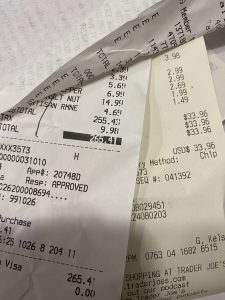
by Heidi Copeland | Oct 16, 2020
Fall is in the air! In addition to the crisp, cool weather comes the season of two of the top consumer spending events: Halloween and the winter holidays.

Receipts add up quickly
Photo Source: Heidi Copeland
In 2019, according to the National Retail Federation’s annual survey, U.S. consumers spent $2.6 billion on Halloween candy alone, about $25 per person. This does not even take into consideration all the other bits and pieces that can go into more elaborate Halloween celebrations: decorations, entertainment and activities, costumes (for kids, adults, and animals), cosmetics, food and drink, and even stationery such as cards and party invitations. Overall, Halloween retail spending was estimated at $8.8 billion in 2019.
Next in line are the winter holidays. These include Thanksgiving, Black Friday, Small Business Saturday, Cyber Monday, Super Saturday, and Christmas. Even with the Covid-19 quarantine, consumers are on track to start the 2020 seasonal spending spike. For many, Covid-19 has provided a state of anxiety, isolation and uncertainty. The upcoming seasonal events can be a big boost in providing a bit of nostalgia, normalcy and fun.
It is important, however, to heed the words of The Cat in the Hat: It’s fun to have fun, but you have to know how!
The truth is the US economy thrives on consumer spending! But, be honest, does derailing your budget for stuff you might have to pay for later really make you feel better? Seasonal spending is the type of spending that can lead families into the New Year with stress and anxiety. Be aware of spending temptations and triggers.
Wikipedia defines temptation as a desire to engage in short-term urges for enjoyment. Anything that promises pleasure can be tempting. Triggers are a stimulus that alerts your brain and body to an old, known experience, which makes it more likely that we will engage and buy something.
For example, a trigger could be a smell. You might think, “I smell cinnamon. Cinnamon reminds me of fall at grandma’s. Her house always smelled like cinnamon.” The temptation would then be: “Cinnamon brooms are at the check-out cashier. I think I will buy one.”
Recognize what sets you up – smells, prices, product placement, etc. There is a method behind the madness of marketing, all of which is geared to attract a consumer to make a purchase. This year especially, anything that offers nostalgia, normalcy, or fun will be a hot commodity.
Knowing your values and goals, and creating a plan for spending (budget), will help you organize your spending. Know, too, it is reasonable to spend money on fun stuff this season of spending. But also remember: happiness is a sense of well-being, joy, or contentment. It is very hard to buy that!

by Heidi Copeland | Sep 28, 2020
Ugh!
Have you ever taken something out of your pantry or cupboard to find the item teeming with pests? I have and it is NOT a good feeling! Recently, I attempted to use raw almonds I had stored in a sealed plastic bag only to discover worms! Yes, worms! Then, upon careful inspection, a few moths! Not only did it ruin my meal plan, it ruined my appetite for almonds!
On the bright side, it forced me to clean out my pantry. I emptied the shelves. I took EVERYTHING out and inspected both the shelving and the food packages/containers. I removed the shelves, vacuumed all the cracks and crevices, washed everything down and used a fan to ensure dry, future pest-free storage. I was lucky; my infestation was limited to a bag of raw almonds purchased a few weeks prior.

Inspect all pantry items before putting them away to eliminate pests. Photo source: Heidi Copeland
However, I learned that almonds could be the harbinger of a moth. And, as you probably know, moths do not actually start out as a moth but as an egg. In nature, the moth lays an egg and the egg hatches to a larva (caterpillar). Upon maturation, the larva forms its pupa (cocoon) and from the pupa emerges the adult moth, only to start the whole cycle over again! Mating and egg laying begin almost immediately after adults emerge from the pupa.
Raw almonds have NOT been heat treated, thus it is pretty common for the product to contain perhaps an element of surprise. (Note: Eating this product with the worm intact hurts nothing other than our psyche!) Although I am certain my moth was an almond moth, the Indianmeal moth has an attraction for the same pheromone (scent). Thus, after buying food, it is extremely important that ALL pantry goods be examined carefully to eliminate the next generation of adults that can fly and contribute to an infestation. EDIS publication EENY-026 Indianmeal Moth is a great publication with pictures of common hiding places. Moths in particular can be found among tree nuts, grains, cereals, spices, herbs, pasta, starches, flour, and even pet foods.
However, pantry pests are not limited to moths. EDIS publication ENY-213 Pantry and Stored Food Pests has pictures and information of the many species of stored food pests found at various times in food pantries. In fact, there is hardly a food item in the kitchen or food pantry that can escape being infested by some pest if it remains unused and exposed in some dark corner or drawer long enough.
To kill insects in infested foods, place food in an oven at 130 degrees F for 30 minutes or in the freezer at 0 degrees F for four days. If freezing, place the food item in a tightly sealed plastic bag to limit condensation on the product, which can lead to mold growth. Defrost the item in the plastic bag and use the product as soon as possible.
During Covid-19, and now hurricane season, consumers have been encouraged to have food on hand for weeks at a time. Now is a good time to take stock of the pantry and learn how to use the FIFO – first in, first out – system of product rotation. FIFO simply encourages prioritization and the use of stored items, so the oldest products are used first.
The presence of stored food pests is not an indication of uncleanliness, since an insect may be brought home in purchased food or on purchased food packages. However, it is important when purchasing any food product, to inspect your purchase to ensure you do not bring home an insect. Even one insect left alone long enough can cause an infestation.

by Heidi Copeland | Sep 25, 2020
Deep regret and guilt are feelings I experience every time I throw something away in my pantry or refrigerator that I have not quite exhausted. What stays? What goes? Does an expiration date really tell you the WHOLE story?
According to the United States Department of Agriculture (USDA), under the jurisdiction of the Food Safety and Inspection Service (FSIS), manufacturers put dates on food products to let retail stores and consumers know how long their products are expected to be their best quality. Except for infant formula, product dating is not required by Federal regulations.

“Best By” date refers to product quality, not safety. Photo source: UF/IFAS NW District
BEST apparently has many interpretations. Food items only need to be labeled in a manner that is truthful and not misleading and in compliance with FSIS regulations.
Many factors determine these quality dates. Additionally, manufacturers and retailers follow strict procedures in the manufacturing, distribution, and storage of food products. However, there is no strict rule to dictate what BEST practices need to be followed once the food leaves the distribution chain and enters, most specifically, our homes. Because of this, food product dating errs on the side of caution.
It has been suggested that date labeling on food products results in consumer confusion and can result in the extraordinary amount of waste at both the retail and consumer level (>30%). Thus, it is important that consumers understand the dates applied to food are for quality, not for safety. The USDA even recognizes that food products are safe to consume past the date on the label, and, regardless of the date, consumers should evaluate the quality of the food product prior to its consumption.
However, it is up to the consumer to understand the significance of product dates and handle food products appropriately.
- “Best if Used By/Before” date indicates when a product will be of best flavor or quality. It is not a purchase or safety date.
- A“Sell-By” date tells the store how long to display the product for sale for inventory management. It is not a safety date.
- “Use-By” date is the last date recommended for the use of the product while at peak quality (it is not a safety date except when used on infant formula).
- “Freeze-By”date indicates when a product should be frozen to maintain peak quality. It is not a purchase or safety date.
- Can codes are a type of closed dating which enables the tracking of product in interstate commerce. These codes also enable manufacturers to rotate their stock and locate their products in the event of a recall. Can codes appear as a series of letters and/or numbers and refer to the date the product was canned. The codes are not meant for the consumer to interpret as a “Best if Used By” date.
Canned goods must exhibit a code or the date of canning. Cans may also display “open” or calendar dates. Usually these are “Best if Used By” dates for peak quality. Discard cans that are dented, rusted, or swollen. High-acid canned foods (e.g. tomatoes and fruits) will keep their best quality for 12 to 18 months; low-acid canned foods (e.g. meats and vegetables) will keep for two to five years.
Additional information on food canning and the handling of canned foods may be found at Shelf-Stable Food Safety.
- Bar Codes on Food Packages are commonly referred to as Universal Product Codes (UPC) and are a type of code that appears on packages as black lines of varying widths above a series of numbers. The UPC is not required by regulation, but manufacturers print them on most product labels because scanners at supermarkets can “read” them quickly to record the price at checkout.
UPCs are also used by stores and manufacturers for inventory purposes and marketing information. When read by a computer, a UPC can reveal such specific information as the manufacturer’s name, product name, size of product, and price. The numbers are not used to identify recalled products.
- Dates on Egg Cartons can indicate either a “Sell-By” or “Expiration” (EXP) date. It is not a federal regulation, but may be required, as defined by the egg laws in the state where the eggs are marketed. Some state egg laws do not allow the use of a “sell-by” date.
Many eggs reach stores only a few days after the hen lays them. Egg cartons with the USDA grade shield on them must display the “pack date” (the day that the eggs were washed, graded, and placed in the carton). This number is a three-digit code that represents the consecutive day of the year starting with January 1 as 001 and ending with December 31 as 365. When a “sell-by” date appears on a carton bearing the USDA grade shield, the code date may not exceed 30 days from the date of pack.
In the United States, after purchasing eggs, it is recommended to refrigerate them in their original carton and place them in the coldest part of the refrigerator, not in the door due to loss of coolness from repeated opening of the door.
The restaurant industry standard, first-in, first-out (FIFO), is also a quick and easy way for the consumer to keep track of their food freshness. FIFO simply means to use food in order of freshness dates. Following the FIFO principle ensures foods with the shortest shelf-life get used first (a permanent marker can help, too).
Throwing something away takes little effort. However, knowing what to keep takes more than a discriminating eye and a keen sense of smell. The Kitchen Companion is a great downloadable resource and reference guide for consumers who are attempting to reduce their own kitchen waste without regret and guilt.
Learn how to be safe, not sorry, without the regret of being wasteful with food products in your home.
Sources:
https://www.fsis.usda.gov/wps/portal/fsis/topics/food-safety-education/get-answers/food-safety-fact-sheets
https://www.fsis.usda.gov/wps/wcm/connect/6c55c954-20a8-46fd-b617-ecffb4449062/Kitchen_Companion_Single.pdf?MOD=AJPERES

by Heidi Copeland | Apr 22, 2020
 Families across the country are adapting to the challenges in daily life caused by the COVID-19 pandemic. Families with children face even more challenges. The task of keeping children occupied, and attempting to keep up with schoolwork, monitoring “screen time,” feeding, etc. is NOT easy!
Families across the country are adapting to the challenges in daily life caused by the COVID-19 pandemic. Families with children face even more challenges. The task of keeping children occupied, and attempting to keep up with schoolwork, monitoring “screen time,” feeding, etc. is NOT easy!
Nonetheless, it is very important to remember that children look to adults for guidance. We can help make lemonade out of lemons, even in the face of a pandemic by focusing on the positive. Adults can model a whole host of problem-solving skills for children of all ages. We can also show children how to be flexible, how to make do and improvise, and how to be compassionate.
As we all work though adjusting to a new normal, know that WFSU public television has expanded their educational services by providing emergency at-home learning content to assist families, students, and teachers throughout their viewing region during the coronavirus outbreak.
The Public Broadcasting Act of 1967 requires Public Media (WFSU) to serve everybody, everywhere, every day for free. WFSU Public Media is doing just that.
WFSU Public Media is working hard pursuing their education mission, clearing their normal daytime schedules, broadcasting grade-appropriate instructional programming, as well as creating and curating educational games and other online content. WFSU educational television programs are geared to helping children succeed in school and in life (https://wfsu.org/education/).
The new daytime WFSU At-Home Learning block of programs begin at 6 a.m., focusing on preschool to 3rd grade learners. You will find “Wild Kratts,” “Daniel Tiger,” “Curious George” and other classic PBS KIDS programs.
At 11 a.m. programming shifts to target middle and high school students. Programs like “Nova” focus on science, “The Great American Read” on English Language Arts, “Masterpiece” on British literature and “American Experience” on U.S. history, just to name some of the PBS programs featured.
Plus, WFSU is working with local school districts to ensure that they can link students to these resources and utilize PBS Learning Media, an online repository of content that is aligned to Florida curriculum standards.
Additionally, WFSU, knowing that their youngest viewers and their families count on the entertaining and educational programs normally shown on the HD channel in the daytime, moved the PBS Kids 24/7 channel, to one of their digital services available free over-the-air and also to Comcast channel 203. It is also live streamed on the WFSU website: https://wfsu.org/education/watch-live-wfsu-pbs-kids-360/.
WFSU Public Media is also providing critical assistance through public safety communications and local programming that gives our communities trustworthy information about every aspect of the health emergency.
Thank you, David Mullins, general manager of WFSU Public Media, including the Florida Channel, and Kim Kelling, director of content and community partnerships at WFSU Public Media. Your timely assistance to every person in your viewing area is much appreciated.
WFSU – TV, Channel 11: Bay, Calhoun, Franklin, Gadsden, Gulf, Jackson, Jefferson, Hamilton, Lafayette, Leon, Liberty, Madison, Taylor, Suwannee, Wakulla counties and Georgia counties Decatur, Grady, Thomas and Seminole.
WFSG – TV, Channel 56: Holmes, Washington and Walton counties

by Heidi Copeland | Mar 25, 2020
It’s hard to believe, but Wednesday, April 22, 2020 marks Earth Day’s 50th anniversary. As far as anniversaries are concerned, the 50th is definitely a milestone, often commemorated with something lasting and treasured.
Kind of ironic then that this year’s Earth Day theme is “Climate Change.” According to the Earth Day Network, this theme represents the biggest challenge to the future of humanity and the life-support systems that make our world habitable.

All these tiny pieces of plastic started out as bigger pieces of plastic, which broke down over time and ended up in our waterways. (Photo source: Tyler Jones, UF/IFAS)
This year’s theme harkens back to 1970, when the first Earth Day was celebrated with an objective to spread awareness. Twenty million Americans (10% of the country’s population at the time) protested environmental ignorance and demanded protections for our planet. These demands eventually led to the passage of landmark environmental laws in the United States, including the Clean Air, Clean Water, and Endangered Species Acts. Many countries soon adopted similar laws.
As Extension agents, we are tasked with providing research-based, reasonable, and helpful information on a variety of topics that can improve people’s lives. Climate change is a divisive issue. In fact, a University of Florida IFAS Extension EDIS fact sheet called “Challenges in Communicating Climate Change to Extension Audiences” outlines the many challenges of discussing climate change with typical audiences.
| Six Americas Audience Categories |
Description |
You might hear |
| Alarmed |
Convinced global warming is a serious and urgent threat; highly engaged; most likely to change behavior |
I’m so upset and worried about the future. |
| Concerned |
Convinced global warming is a serious threat; somewhat engaged; less likely to change behavior |
I think this is something politicians should address |
| Cautious |
Believe global warming is a problem but not a personal or urgent threat |
So what is it all about? |
| Disengaged |
Give little thought to global warming; change beliefs easily; not perceived as a problem for them |
I have other things to think about, like how to pay the bills. |
| Doubtful |
Not sure if global warming is happening |
Seems like climate always changes. This is a political issue. |
| Dismissive |
Firmly believe global warming is not occurring; highly engaged in preventing change in policies; very knowledgeable |
It is arrogant to believe that people can change the climate. This graph shows the scientists have it wrong. |
Nonetheless, Extension agents are well-informed and desperately care for the health and welfare of their families, neighbors, and communities. Especially now, as collectively, we all are facing an uncertain future.
The coronavirus pandemic has stressed our lives right now. Everyone is grappling with change. Everyone is worried about human health. Even with everything else going on, Earth Day is a yearly reminder to exercise our collective responsibility. As one human race, we just can’t sit back and relax and hope everything turns out okay. It is going to take some work.
So instead of feeling like our time is being wasted by staying at home, perhaps we can spend this time in a positive way. I heard a news commentator recently say something along the lines of not letting this time we all have now to use us, but for us to use this time to come out better on the other end.
Like Helen Keller famously said, “Alone we can do so little; together we can do so much.” Let’s start together.
Here are some tips and resources for saving energy, money, and the environment:
Save Energy, Save Money (https://www.energy.gov/energysaver/energy-saver)
-
- Install a programmable thermometer
- Hang clothes to dry when you can
- Look for energy star appliances when shopping for a replacement
- Change to energy efficient light bulbs
Understand personal water consumption (https://www.epa.gov/watersense/how-we-use-water#Daily%20Life)
Say NO to plastic (https://www.epa.gov/trash-free-waters/toxicological-threats-plastic)
-
- Carry your own reusable bag
Eat with a conscience (http://www.floridaclimateinstitute-uf.org/)
-
- Eat more meatless meals
- Don’t waste food
- Cook more
Think about personal consumption (https://moneytalk1.blogspot.com/2020/03/when-things-seem-out-of-control-control.html)
-
- Consume less
- Waste less
- Enjoy yourself more
Support your leading environmental movements. Youth around the globe are passionate about this. They worry, and rightly so, about what is going to happen, now and in the future.










